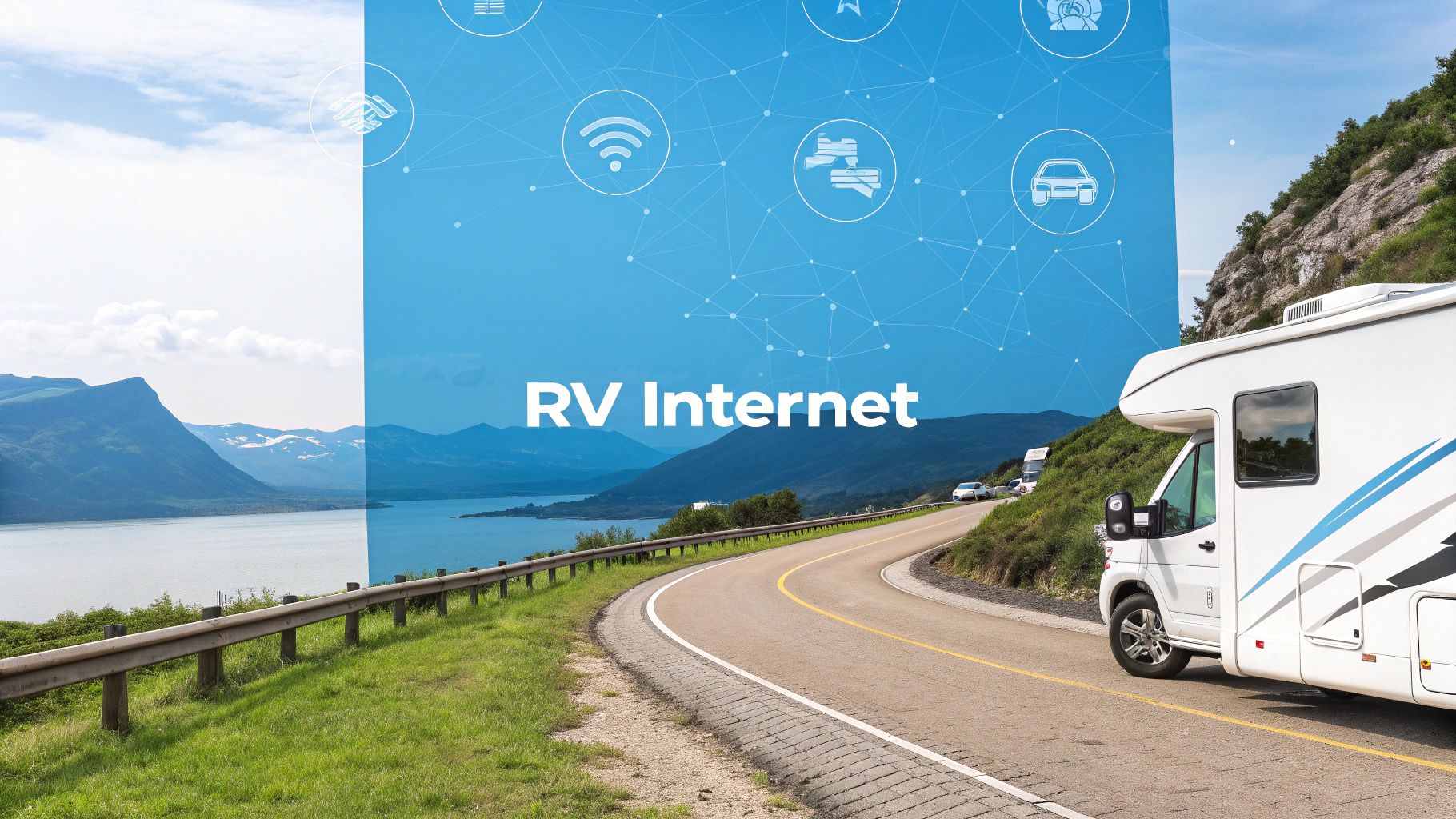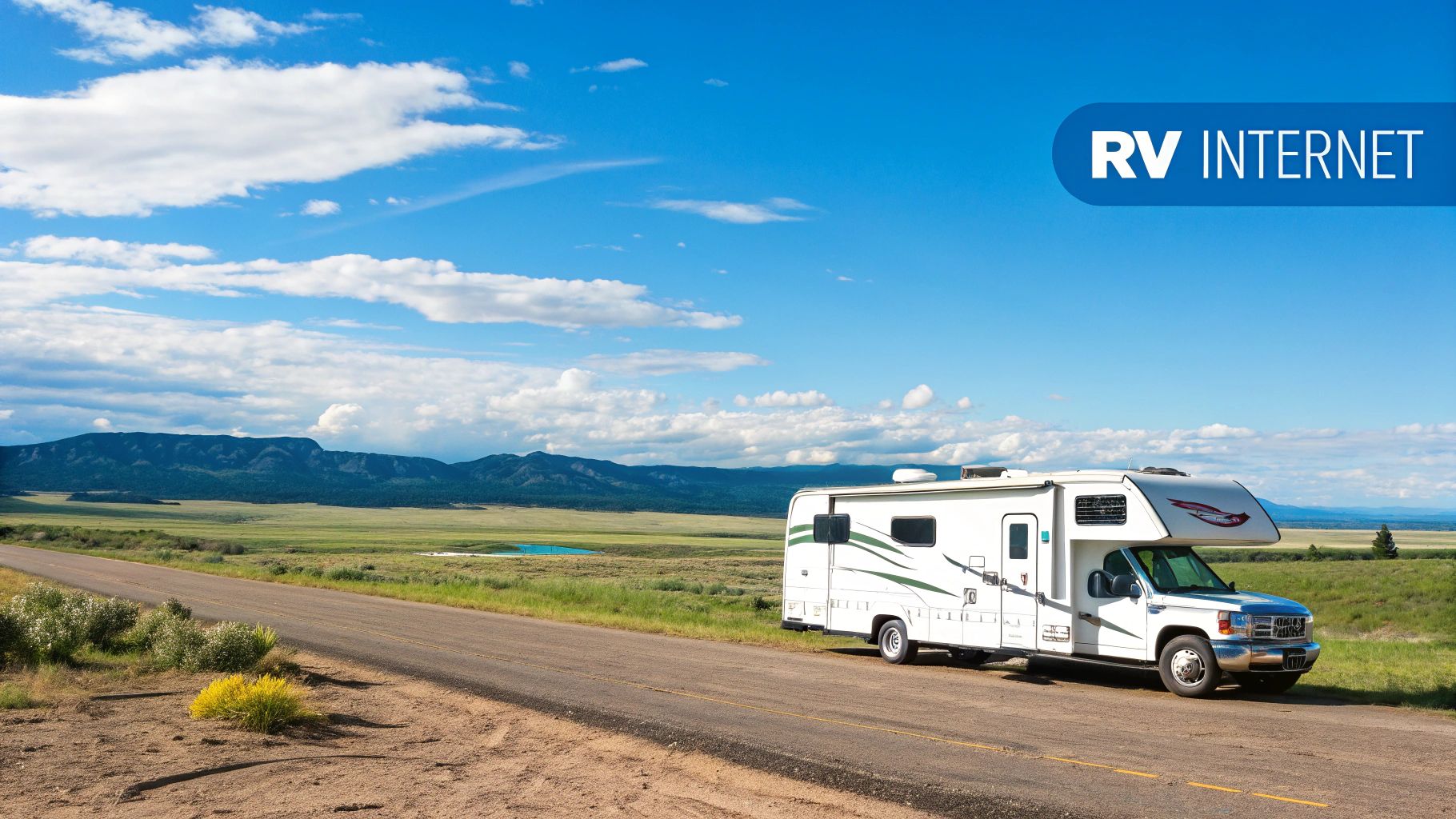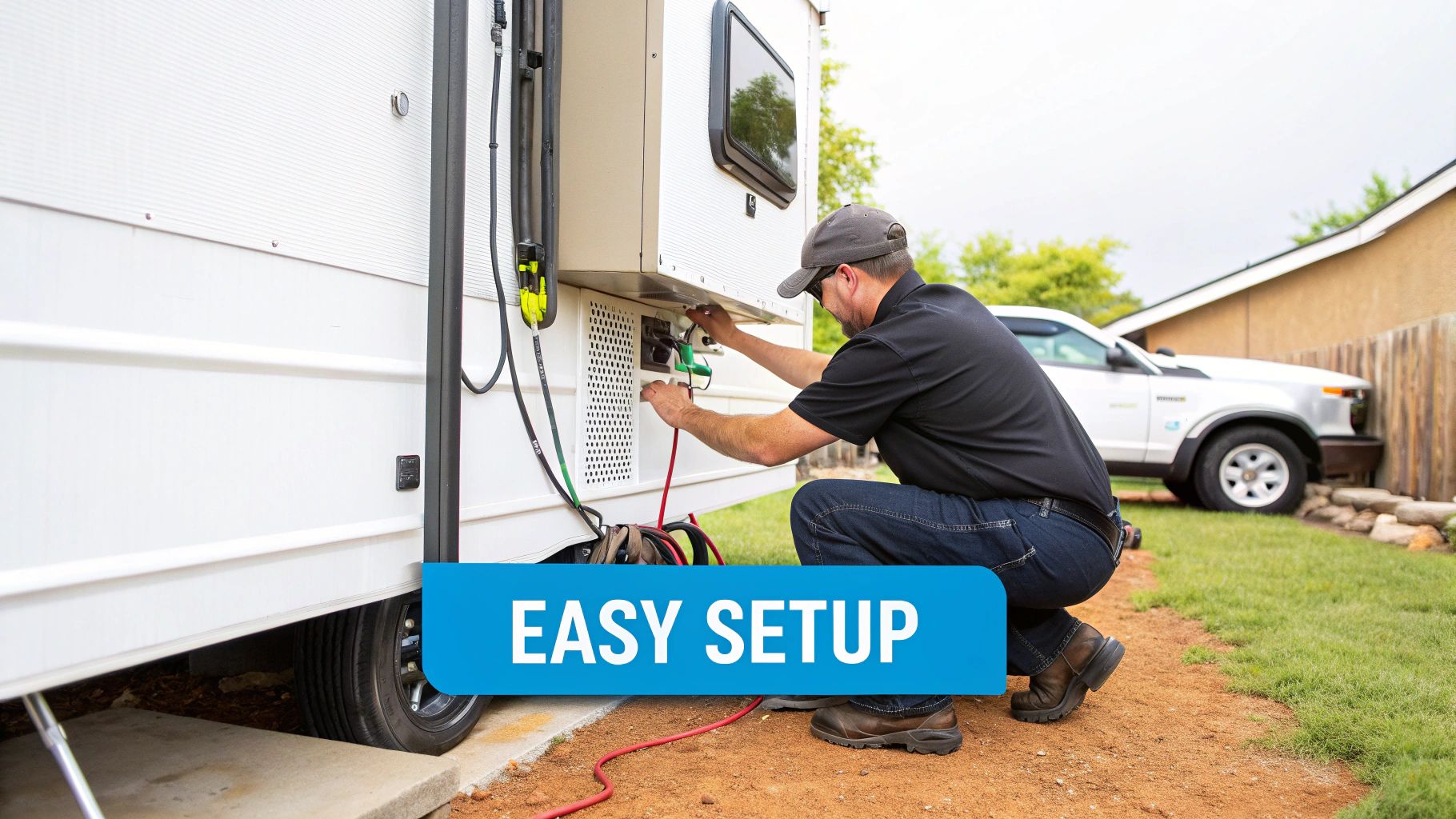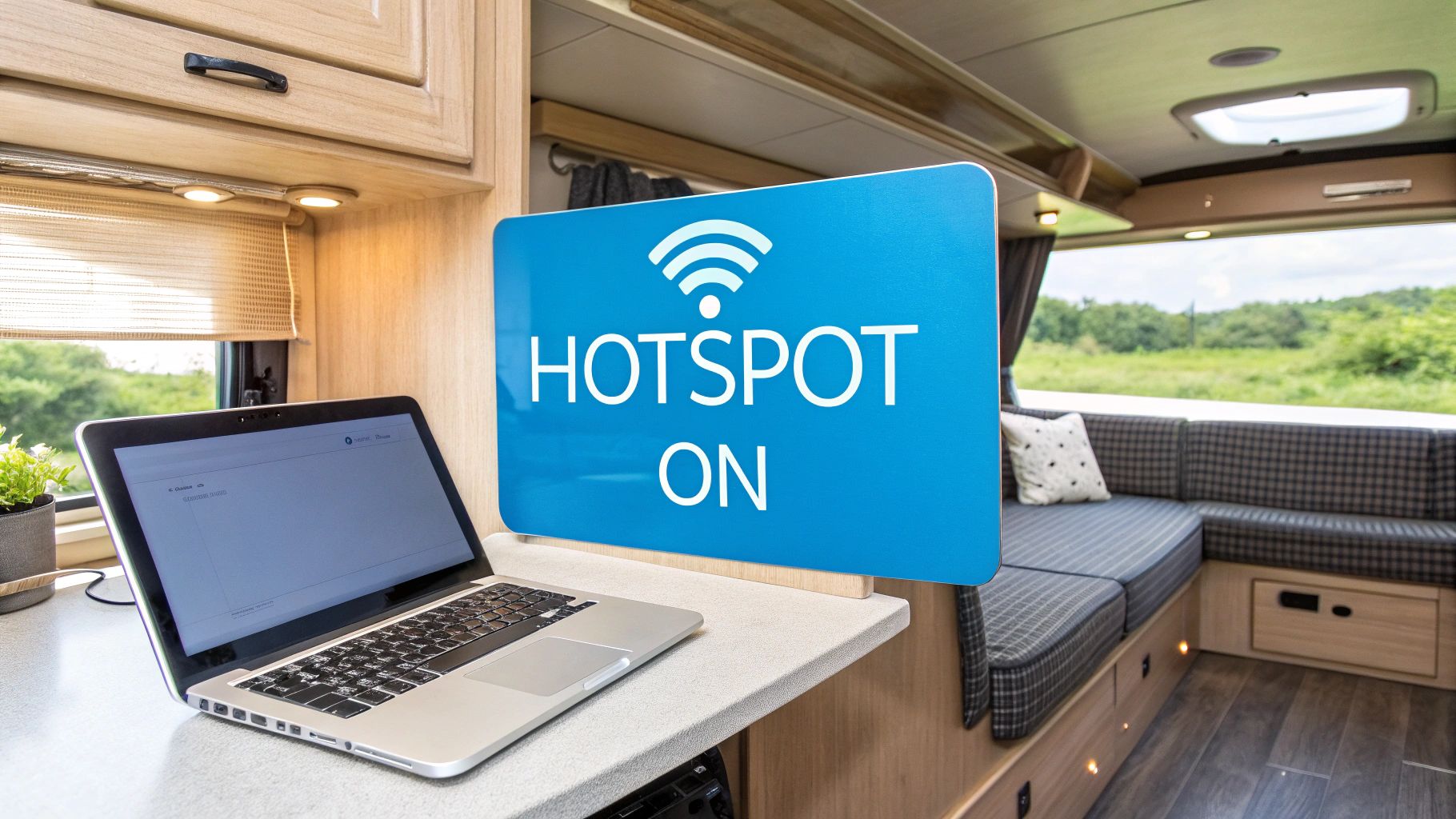

· Por James
How to Get Internet in RV: Easy, Reliable Solutions
Navigating Your RV Internet Options Without Confusion

Choosing the right internet solution for your RV can be a daunting task. With a plethora of options available, each boasting its own pros and cons, it's easy to feel overwhelmed. The key to staying connected on the open road is understanding these options and how they align with your specific needs. This involves considering factors such as your travel style, budget, and technical proficiency.
Understanding Your Connectivity Needs
Before delving into specific internet solutions, take some time to assess your online habits. How do you envision using the internet in your RV? Will you be working remotely, streaming movies, or simply catching up on emails and browsing the web? The bandwidth requirements for video conferencing, for instance, are significantly higher than those for checking social media.
This assessment will heavily influence the type of connection you'll need. A basic cellular plan might suffice for casual browsing, while a more robust satellite internet connection might be necessary for consistent video calls.
Exploring the Landscape of RV Internet
Several primary methods exist for accessing the internet in your RV. Cellular data offers flexibility and generally provides good speeds in populated areas, making it a popular choice. However, coverage can be unreliable in more rural locations.
Satellite internet, conversely, offers near-global coverage, making it ideal for adventurers who prefer off-the-beaten-path destinations. However, traditional satellite internet can be pricey and may experience latency issues.
Additionally, campground Wi-Fi can supplement your primary connection. However, it's often unreliable and slow, best used as a backup option. The key to uninterrupted connectivity lies in finding the right balance between these options.
As of 2023, over 60% of the global population has internet access, highlighting the growing importance of connectivity in our modern lives. This increasing demand for internet access, even in RVs, reflects the rise of digital nomadism and the need for reliable mobile solutions. You can find more detailed statistics here: Learn more about global internet access.
Choosing the Right Path for Your RV Adventures
Selecting the best internet solution for your RV hinges on a few key factors. Your travel style plays a crucial role. If you mainly stay in campgrounds with Wi-Fi, a simple Wi-Fi booster might be sufficient. However, for boondocking or off-grid adventures, a satellite or cellular solution is essential.
Budget is another significant consideration, as different options come with varying costs. Finally, consider your technical comfort level. Some systems require more complex setup and maintenance than others. Carefully weighing these factors will ensure you find the ideal solution to stay connected throughout your RV travels.
Mastering Cellular Solutions for Consistent Connectivity

Cellular data is essential for internet access on the road. Understanding how to maximize your connection is key to a smooth online experience, especially as you travel through varied landscapes. Savvy RVers have learned tricks and techniques to maintain a strong signal, and you can too.
Evaluating Cellular Coverage Maps
Coverage maps from providers like Verizon and AT&T can be helpful starting points. However, they don't always reflect the reality on the ground. Obstacles like mountains and dense forests can significantly impact signal strength, even in areas marked as having strong coverage.
Don't rely solely on marketing materials. Seek out real-world experiences from fellow RVers. Online forums and RV communities offer valuable insights into actual coverage in specific locations. You'll get firsthand accounts that can save you from connectivity headaches down the road.
Nearly 59% of all web traffic is mobile, highlighting the importance of a solid cellular connection, especially for those on the move. For more detailed statistics, you can Explore this topic further. Being prepared with the right tools and knowledge will make all the difference in your online experience.
Choosing The Right Cellular Plan
Choosing a cellular plan requires understanding the differences between unlimited data and hotspot-friendly options. Many unlimited plans throttle, or reduce, data speeds after a certain amount of hotspot usage. This can severely impact data-intensive activities like streaming or video calls.
Consider plans specifically designed for mobile hotspots. Another strategy is using multiple carriers with smaller data allowances to distribute your usage. This can help you avoid throttling and maintain consistent speeds.
The following table provides a comparison of major cellular providers and their offerings for RV users. This overview will help you understand the landscape of available options.
Major Cellular Providers Comparison for RV Users
| Provider | Coverage Area | Unlimited Plan Cost | Hotspot Data | Rural Performance |
|---|---|---|---|---|
| Verizon | Extensive | Varies | Varies depending on plan | Generally strong |
| AT&T | Wide | Varies | Varies depending on plan | Can be inconsistent |
| T-Mobile | Growing | Varies | Varies depending on plan | Improving, but spotty in some areas |
This table summarizes key features for RVers. Remember to research specific plans and consider your individual data needs and travel patterns.
Boosting Your Cellular Signal
Even with the best cellular plan, weak signals can occur. Cellular boosters, like those from weBoost, amplify weak signals, often making the difference between no connection and a usable one. Placement of the booster’s external antenna is critical for optimal performance.
Positioning the antenna high on your RV, away from obstructions, can drastically improve signal strength. Experiment with different locations to find the sweet spot for your setup.
Managing Multiple Carriers
Juggling multiple carriers can be an effective way to maximize coverage and minimize throttling. This typically involves using SIM cards from different providers and switching between them based on location and signal strength.
Some RVers utilize dedicated routers that automatically connect to the strongest available signal. This simplifies the process but requires careful monitoring of data usage across different plans. This strategy can save you money and frustration in the long run. Mastering cellular solutions for your RV involves research, planning, and a willingness to adapt.
Conquering Remote Areas With Satellite Internet

When cell service disappears, satellite internet becomes essential for staying connected in your RV, especially in remote locations. This section explores the practicalities of using satellite internet for mobile living, providing insights into real-world performance and setup considerations.
Understanding Satellite Internet Options for RVs
Satellite internet for RVs comes in two main types: geostationary orbit (GEO) and low Earth orbit (LEO). GEO systems are the traditional option, with satellites positioned far from Earth. This results in wider coverage but can introduce latency, a delay in data transmission noticeable during activities like video calls.
LEO systems are a newer technology using satellites much closer to Earth. This significantly reduces latency, creating a more responsive online experience. However, LEO systems can have more limited coverage compared to GEO systems.
Installation and Power Considerations
Installing satellite internet on an RV has unique challenges. GEO systems often require precise aiming of a dish antenna at the satellite, which can be difficult on a moving vehicle. Some newer systems offer automatic antenna pointing, simplifying the process.
LEO systems often have smaller, less obtrusive antennas, making installation easier. However, mounting solutions need to be sturdy enough to handle vibrations and movement during travel. Power consumption is also important. Satellite systems need a dedicated power source, which can affect your RV's electrical system.
Debunking Myths About Satellite Internet Speeds and Weather Impacts
One common misconception is that satellite internet is always slow. While speeds can be slower than cellular or fiber connections, modern satellite systems offer surprisingly good performance, particularly LEO options.
Another myth is that satellite internet is unaffected by weather. Heavy rain or snow can temporarily disrupt the signal, causing slower speeds or outages. Understanding these limitations helps manage expectations and plan accordingly.
Integrating Satellite Connectivity Into Your Mobile Setup
Integrating satellite internet into your RV setup requires careful planning and consideration of your needs. If you primarily use the internet for email and web browsing, a GEO system might suffice. However, if you need video calls or online gaming, a LEO system's lower latency will likely provide a better experience.
Budget is also a key factor. Satellite internet can be more expensive than cellular options, so factor this into your overall connectivity costs. By understanding the realities of satellite internet, you can make informed decisions and stay connected, even in the most remote areas.
Transforming Weak WiFi Into Strong Connections

For RVers who frequently rely on campground or public Wi-Fi, having the right equipment can significantly improve the online experience. This isn't just about convenience; it's about staying productive and entertained on the road. This section explores how to transform weak, unreliable Wi-Fi into a strong and consistent connection.
Understanding WiFi Extenders, Repeaters, and Boosters
Many people use the terms "extender," "repeater," and "booster" interchangeably. However, they have distinct meanings. A Wi-Fi extender expands your existing network's range by receiving and rebroadcasting the signal. A repeater duplicates the signal without necessarily increasing its strength. A Wi-Fi booster is a broader term encompassing devices that amplify the Wi-Fi signal. This might include the functionalities of both extenders and repeaters.
Understanding these differences is crucial for selecting the correct tool for your RV. Choosing the right solution hinges on your specific needs and the layout of your RV and campground. For instance, if your RV is parked far from the campground's Wi-Fi source, an extender might be the best option. If the signal is weak throughout your RV, a booster might be more effective.
To help you choose the right system for your RV, we've compiled a comparison of some popular options.
The table below provides a comprehensive comparison of popular WiFi extending solutions designed specifically for RV use.
| System | Range | Installation Difficulty | Price Range | Best Use Case |
|---|---|---|---|---|
| Winegard ConnecT 2.0 | Varies depending on cellular signal | Easy | $300-$500 (plus data plan) | All-around connectivity, including 4G LTE and Wi-Fi |
| Weboost Drive Reach RV | Improves existing cellular signal | Moderate | $500-$700 | Boosting weak cellular signals for multiple devices |
| King WiFiMax Extend | Extends existing Wi-Fi network | Easy | $100-$200 | Extending campground Wi-Fi to reach your RV |
| Alfa WiFi Camp Pro 2 | Long-range Wi-Fi reception | Moderate | $100-$150 | Connecting to distant Wi-Fi networks |
This table highlights some key features and price points to consider when choosing a WiFi system for your RV. Remember to research each option thoroughly to determine which best suits your individual needs.
Maximizing Reception Without Damaging Your RV
Proper antenna placement is vital for maximizing your device's effectiveness. For RVs, this often involves placing the antenna outside, potentially on the roof or a ladder mount. Securely mount the antenna to withstand wind and movement while driving. Use high-quality cables and connectors to minimize signal loss. This might involve drilling small holes for cable routing, so proceed cautiously to avoid damaging your RV's structure or wiring.
Security On Public Wi-Fi Networks
Public Wi-Fi networks, such as those found in campgrounds, are often less secure than private networks. Using a Virtual Private Network (VPN) encrypts your internet traffic and protects your data. This is particularly important when accessing sensitive information, such as online banking or personal email. NordVPN is one example of a VPN service. A VPN creates a secure tunnel for your data, making it difficult for others on the network to intercept it. Remain cautious about the websites you visit and the files you download on public Wi-Fi.
Configuration and Setup
Most Wi-Fi extending solutions are designed for easy setup, even for those less familiar with technology. Many devices include user-friendly interfaces that guide you through the configuration process. This often involves connecting the device to your RV’s power supply, scanning for available Wi-Fi networks, and entering the network password. However, even user-friendly devices may have specific configuration requirements. Review these requirements before your trip.
Getting internet access in your RV is a multifaceted question. Boosting campground Wi-Fi is just one piece of the puzzle. By understanding the available options, you can transform weak signals into reliable connections. This ensures you enjoy all the benefits of the internet while on the road.
Building Your Bulletproof Multi-Connection Setup
Staying connected on the road demands a solid backup plan – and ideally, multiple backups. Seasoned RVers know relying on a single connection is a recipe for disaster. This section explores building a robust, multi-connection setup for uninterrupted internet access in your RV.
The Importance of Redundancy
Imagine depending solely on campground Wi-Fi, only to find it sluggish and overloaded. Or picture your cellular signal vanishing right before an important video conference. These situations underscore why redundancy is crucial for RV internet.
A multi-connection setup lets you seamlessly switch between internet sources, ensuring consistent connectivity no matter where you are. This offers invaluable peace of mind, knowing you’re always prepared for connectivity issues.
Load-Balancing Routers: Your Connectivity Control Center
A load-balancing router forms the core of a multi-connection setup. This device connects to multiple internet sources at once – for example, cellular data, Starlink satellite internet, and Wi-Fi. The router intelligently distributes internet traffic, optimizing performance and speed.
Some routers even prioritize connections based on your needs. You might prioritize a faster cellular connection for streaming while using Wi-Fi for email. This ensures the best connection for every activity.
Automated Failover for Seamless Transitions
Automated failover is a key feature of load-balancing routers. If your primary connection fails, the router automatically switches to your secondary connection without interruption. It’s like a backup generator activating when the power goes out. You'll hardly notice the change, allowing you to continue working or streaming seamlessly.
Prioritizing Connections Based on Location and Needs
Your internet needs change based on your location and activities. In a campground with reliable Wi-Fi, you might prioritize that connection to save cellular data. When boondocking, satellite internet becomes essential.
A well-designed multi-connection setup allows you to adjust priorities as needed, adapting to changing circumstances. This flexibility maximizes both performance and cost-effectiveness. You can even set automated rules within your router to switch between connections based on signal strength.
Security and Convenience in Your Network Configuration
Building a multi-connection setup isn’t just about speed and redundancy; it's also about security. Configure your router with a strong password and the latest firmware updates. When using public Wi-Fi, consider a Virtual Private Network (VPN) to encrypt your internet traffic and safeguard your data.
A robust multi-connection setup ultimately offers peace of mind. It ensures internet access regardless of location, providing consistent connectivity for work, entertainment, and staying in touch. By planning and investing in the right equipment, you can enjoy uninterrupted internet throughout your RV travels.
Managing Connectivity Costs Without Breaking the Bank
Reliable internet access is essential for RV life, but staying connected on the road requires careful budget management. This section explores balancing the need for connectivity with the realities of a travel budget. We'll cover practical strategies used by full-time RVers to control data usage and find affordable connection options.
Understanding the Complete Expense Picture
The cost of RV internet involves more than just monthly service fees. Factor in the initial investment in equipment like cellular boosters, antennas, and routers. These upfront costs can vary greatly depending on the chosen connectivity solution. A basic Wi-Fi extender might cost under $100, while a satellite internet system could require an investment of $500 or more.
Monthly service commitments also fluctuate. Cellular plans range from basic packages with limited data to unlimited options, which often come with higher price tags. Satellite internet plans also have tiered pricing based on speed and data allowances. Don't forget to consider potential maintenance and repair costs, especially for more complex setups.
Monitoring and Controlling Data Usage
Keeping track of your data consumption is the first step toward controlling costs. Most cellular providers offer online tools or apps to monitor data usage. Setting up usage alerts can prevent unexpected overage charges.
Actively managing your data usage can significantly impact your monthly bill. Limiting streaming, using data compression tools, and downloading large files only when connected to Wi-Fi are effective ways to conserve data.
Finding Free or Low-Cost Connection Opportunities
Many free or low-cost internet options can supplement your primary connection. Public libraries, coffee shops, and some retail stores often offer free Wi-Fi. Some campgrounds provide Wi-Fi as well, though the quality and speed can be inconsistent.
Strategically utilizing these free resources can lessen your reliance on paid services. Planning your route to include stops near libraries or coffee shops allows you to check emails or work without dipping into your cellular data.
Budgeting for Different Travel Styles and Income Levels
Creating a realistic internet budget depends on individual travel style and income. If you mostly stay in campgrounds with Wi-Fi, your internet costs may be minimal. However, for frequent boondocking, investing in a satellite or cellular system becomes essential.
Set aside a specific part of your travel budget for internet access. This amount should align with your needs and anticipated usage. Flexible budgeting is key; reassess and adjust your budget based on your actual usage patterns and changing connectivity needs.
Prioritizing Connectivity Spending for Long-Term Value
Prioritizing your connectivity spending helps you get the best value over time. Investing in reliable equipment, even if it has a higher upfront cost, can save money on repairs and frustration in the long run.
Choosing a connectivity solution that can adapt to your changing needs is also important. Starting with a basic setup and upgrading as needed prevents unnecessary spending on equipment that may not perform well in real-world travel conditions.
Savvy RVers understand internet access is a vital part of their travel experience, not a luxury. By managing costs effectively, you can stay connected without exceeding your budget, allowing you to work, learn, and enjoy entertainment on the road.
For a reliable internet solution designed for RV travelers, consider SwiftNet Wifi. Their high-speed 5G service aims to provide consistent connectivity, even in rural areas. Learn more about their plans and coverage at SwiftNet Wifi.
Article created using Outrank

